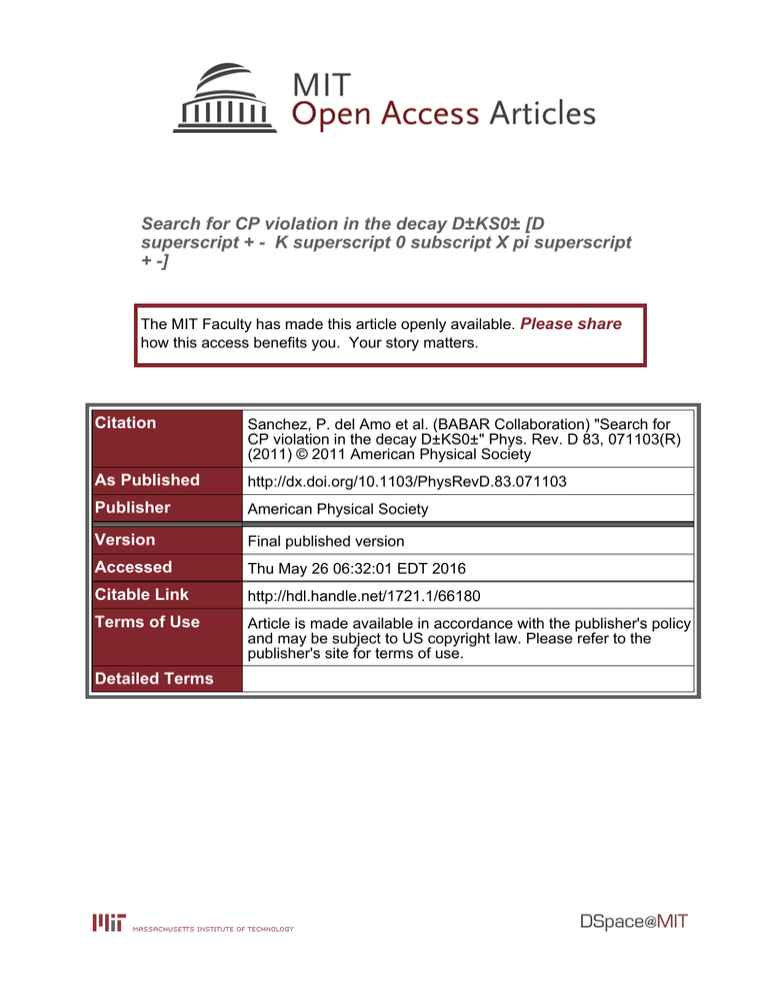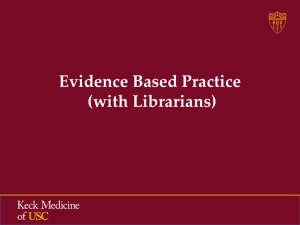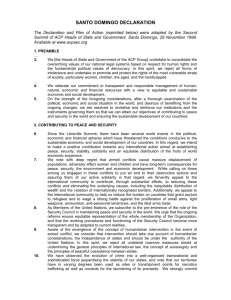Search for CP violation in the decay D±KS0± [D
advertisement

Search for CP violation in the decay D±KS0± [D superscript + - K superscript 0 subscript X pi superscript + -] The MIT Faculty has made this article openly available. Please share how this access benefits you. Your story matters. Citation Sanchez, P. del Amo et al. (BABAR Collaboration) "Search for CP violation in the decay D±KS0±" Phys. Rev. D 83, 071103(R) (2011) © 2011 American Physical Society As Published http://dx.doi.org/10.1103/PhysRevD.83.071103 Publisher American Physical Society Version Final published version Accessed Thu May 26 06:32:01 EDT 2016 Citable Link http://hdl.handle.net/1721.1/66180 Terms of Use Article is made available in accordance with the publisher's policy and may be subject to US copyright law. Please refer to the publisher's site for terms of use. Detailed Terms RAPID COMMUNICATIONS PHYSICAL REVIEW D 83, 071103(R) (2011) Search for CP violation in the decay D ! KS0 P. del Amo Sanchez,1 J. P. Lees,1 V. Poireau,1 E. Prencipe,1 V. Tisserand,1 J. Garra Tico,2 E. Grauges,2 M. Martinelli,3a,3b D. A. Milanes,3a A. Palano,3a,3b M. Pappagallo,3a,3b G. Eigen,4 B. Stugu,4 L. Sun,4 D. N. Brown,5 L. T. Kerth,5 Yu. G. Kolomensky,5 G. Lynch,5 I. L. Osipenkov,5 H. Koch,6 T. Schroeder,6 D. J. Asgeirsson,7 C. Hearty,7 T. S. Mattison,7 J. A. McKenna,7 A. Khan,8 V. E. Blinov,9 A. R. Buzykaev,9 V. P. Druzhinin,9 V. B. Golubev,9 E. A. Kravchenko,9 A. P. Onuchin,9 S. I. Serednyakov,9 Yu. I. Skovpen,9 E. P. Solodov,9 K. Yu. Todyshev,9 A. N. Yushkov,9 M. Bondioli,10 S. Curry,10 D. Kirkby,10 A. J. Lankford,10 M. Mandelkern,10 E. C. Martin,10 D. P. Stoker,10 H. Atmacan,11 J. W. Gary,11 F. Liu,11 O. Long,11 G. M. Vitug,11 C. Campagnari,12 T. M. Hong,12 D. Kovalskyi,12 J. D. Richman,12 C. A. West,12 A. M. Eisner,13 C. A. Heusch,13 J. Kroseberg,13 W. S. Lockman,13 A. J. Martinez,13 T. Schalk,13 B. A. Schumm,13 A. Seiden,13 L. O. Winstrom,13 C. H. Cheng,14 D. A. Doll,14 B. Echenard,14 D. G. Hitlin,14 P. Ongmongkolkul,14 F. C. Porter,14 A. Y. Rakitin,14 R. Andreassen,15 M. S. Dubrovin,15 B. T. Meadows,15 M. D. Sokoloff,15 P. C. Bloom,16 W. T. Ford,16 A. Gaz,16 M. Nagel,16 U. Nauenberg,16 J. G. Smith,16 S. R. Wagner,16 R. Ayad,17,* W. H. Toki,17 H. Jasper,18 A. Petzold,18 B. Spaan,18 M. J. Kobel,19 K. R. Schubert,19 R. Schwierz,19 D. Bernard,20 M. Verderi,20 P. J. Clark,21 S. Playfer,21 J. E. Watson,21 M. Andreotti,22a,22b D. Bettoni,22a C. Bozzi,22a R. Calabrese,22a,22b A. Cecchi,22a,22b G. Cibinetto,22a,22b E. Fioravanti,22a,22b P. Franchini,22a,22b I. Garzia,22a,22b E. Luppi,22a,22b M. Munerato,22a,22b M. Negrini,22a,22b A. Petrella,22a,22b L. Piemontese,22a R. Baldini-Ferroli,23 A. Calcaterra,23 R. de Sangro,23 G. Finocchiaro,23 M. Nicolaci,23 S. Pacetti,23 P. Patteri,23 I. M. Peruzzi,23,† M. Piccolo,23 M. Rama,23 A. Zallo,23 R. Contri,24a,24b E. Guido,24a,24b M. Lo Vetere,24a,24b M. R. Monge,24a,24b S. Passaggio,24a C. Patrignani,24a,24b E. Robutti,24a B. Bhuyan,25 V. Prasad,25 C. L. Lee,26 M. Morii,26 A. J. Edwards,27 A. Adametz,28 J. Marks,28 U. Uwer,28 F. U. Bernlochner,29 M. Ebert,29 H. M. Lacker,29 T. Lueck,29 A. Volk,29 P. D. Dauncey,30 M. Tibbetts,30 P. K. Behera,31 U. Mallik,31 C. Chen,32 J. Cochran,32 H. B. Crawley,32 W. T. Meyer,32 S. Prell,32 E. I. Rosenberg,32 A. E. Rubin,32 A. V. Gritsan,33 Z. J. Guo,33 N. Arnaud,34 M. Davier,34 D. Derkach,34 J. Firmino da Costa,34 G. Grosdidier,34 F. Le Diberder,34 A. M. Lutz,34 B. Malaescu,34 A. Perez,34 P. Roudeau,34 M. H. Schune,34 J. Serrano,34 V. Sordini,34,‡ A. Stocchi,34 L. Wang,34 G. Wormser,34 D. J. Lange,35 D. M. Wright,35 I. Bingham,36 C. A. Chavez,36 J. P. Coleman,36 J. R. Fry,36 E. Gabathuler,36 D. E. Hutchcroft,36 D. J. Payne,36 C. Touramanis,36 A. J. Bevan,37 F. Di Lodovico,37 R. Sacco,37 M. Sigamani,37 G. Cowan,38 S. Paramesvaran,38 A. C. Wren,38 D. N. Brown,39 C. L. Davis,39 A. G. Denig,40 M. Fritsch,40 W. Gradl,40 A. Hafner,40 K. E. Alwyn,41 D. Bailey,41 R. J. Barlow,41 G. Jackson,41 G. D. Lafferty,41 J. Anderson,42 R. Cenci,42 A. Jawahery,42 D. A. Roberts,42 G. Simi,42 J. M. Tuggle,42 C. Dallapiccola,43 E. Salvati,43 R. Cowan,44 D. Dujmic,44 G. Sciolla,44 M. Zhao,44 D. Lindemann,45 P. M. Patel,45 S. H. Robertson,45 M. Schram,45 P. Biassoni,46a,46b A. Lazzaro,46a,46b V. Lombardo,46a F. Palombo,46a,46b S. Stracka,46a,46b L. Cremaldi,47 R. Godang,47,x R. Kroeger,47 P. Sonnek,47 D. J. Summers,47 X. Nguyen,48 M. Simard,48 P. Taras,48 G. De Nardo,49a,49b D. Monorchio,49a,49b G. Onorato,49a,49b C. Sciacca,49a,49b G. Raven,50 H. L. Snoek,50 C. P. Jessop,51 K. J. Knoepfel,51 J. M. LoSecco,51 W. F. Wang,51 L. A. Corwin,52 K. Honscheid,52 R. Kass,52 N. L. Blount,53 J. Brau,53 R. Frey,53 O. Igonkina,53 J. A. Kolb,53 R. Rahmat,53 N. B. Sinev,53 D. Strom,53 J. Strube,53 E. Torrence,53 G. Castelli,54a,54b E. Feltresi,54a,54b N. Gagliardi,54a,54b M. Margoni,54a,54b M. Morandin,54a A. Pompili,54a,54b M. Posocco,54a M. Rotondo,54a F. Simonetto,54a,54b R. Stroili,54a,54b E. Ben-Haim,55 M. Bomben,55 G. R. Bonneaud,55 H. Briand,55 G. Calderini,55 J. Chauveau,55 O. Hamon,55 Ph. Leruste,55 G. Marchiori,55 J. Ocariz,55 J. Prendki,55 S. Sitt,55 M. Biasini,56a,56b E. Manoni,56a,56b A. Rossi,56a,56b C. Angelini,57a,57b G. Batignani,57a,57b S. Bettarini,57a,57b M. Carpinelli,57a,57b,k G. Casarosa,57a,57b A. Cervelli,57a,57b F. Forti,57a,57b M. A. Giorgi,57a,57b A. Lusiani,57a,57c N. Neri,57a,57b E. Paoloni,57a,57b G. Rizzo,57a,57b J. J. Walsh,57a D. Lopes Pegna,58 C. Lu,58 J. Olsen,58 A. J. S. Smith,58 A. V. Telnov,58 F. Anulli,59a E. Baracchini,59a,59b G. Cavoto,59a R. Faccini,59a,59b F. Ferrarotto,59a F. Ferroni,59a,59b M. Gaspero,59a,59b L. Li Gioi,59a M. A. Mazzoni,59a G. Piredda,59a F. Renga,59a,59b C. Buenger,60 T. Hartmann,60 T. Leddig,60 H. Schröder,60 R. Waldi,60 T. Adye,61 E. O. Olaiya,61 F. F. Wilson,61 S. Emery,62 G. Hamel de Monchenault,62 G. Vasseur,62 Ch. Yèche,62 M. T. Allen,63 D. Aston,63 D. J. Bard,63 R. Bartoldus,63 J. F. Benitez,63 C. Cartaro,63 M. R. Convery,63 J. Dorfan,63 G. P. Dubois-Felsmann,63 W. Dunwoodie,63 R. C. Field,63 M. Franco Sevilla,63 B. G. Fulsom,63 A. M. Gabareen,63 M. T. Graham,63 P. Grenier,63 C. Hast,63 W. R. Innes,63 M. H. Kelsey,63 H. Kim,63 P. Kim,63 M. L. Kocian,63 D. W. G. S. Leith,63 P. Lewis,63 S. Li,63 B. Lindquist,63 S. Luitz,63 V. Luth,63 H. L. Lynch,63 D. B. MacFarlane,63 D. R. Muller,63 H. Neal,63 S. Nelson,63 C. P. O’Grady,63 I. Ofte,63 M. Perl,63 T. Pulliam,63 B. N. Ratcliff,63 A. Roodman,63 A. A. Salnikov,63 V. Santoro,63 R. H. Schindler,63 J. Schwiening,63 A. Snyder,63 D. Su,63 M. K. Sullivan,63 S. Sun,63 K. Suzuki,63 J. M. Thompson,63 J. Va’vra,63 A. P. Wagner,63 M. Weaver,63 W. J. Wisniewski,63 M. Wittgen,63 D. H. Wright,63 H. W. Wulsin,63 A. K. Yarritu,63 C. C. Young,63 V. Ziegler,63 1550-7998= 2011=83(7)=071103(8) 071103-1 Ó 2011 American Physical Society RAPID COMMUNICATIONS P. DEL AMO SANCHEZ et al. 64 64 PHYSICAL REVIEW D 83, 071103(R) (2011) 64 64 64 X. R. Chen, W. Park, M. V. Purohit, R. M. White, J. R. Wilson, A. Randle-Conde,65 S. J. Sekula,65 M. Bellis,66 P. R. Burchat,66 T. S. Miyashita,66 S. Ahmed,67 M. S. Alam,67 J. A. Ernst,67 B. Pan,67 M. A. Saeed,67 S. B. Zain,67 N. Guttman,68 A. Soffer,68 P. Lund,69 S. M. Spanier,69 R. Eckmann,70 J. L. Ritchie,70 A. M. Ruland,70 C. J. Schilling,70 R. F. Schwitters,70 B. C. Wray,70 J. M. Izen,71 X. C. Lou,71 F. Bianchi,72a,72b D. Gamba,72a,72b M. Pelliccioni,72a,72b L. Lanceri,73a,73b L. Vitale,73a,73b N. Lopez-March,74 F. Martinez-Vidal,74 A. Oyanguren,74 H. Ahmed,75 J. Albert,75 Sw. Banerjee,75 H. H. F. Choi,75 K. Hamano,75 G. J. King,75 R. Kowalewski,75 M. J. Lewczuk,75 C. Lindsay,75 I. M. Nugent,75 J. M. Roney,75 R. J. Sobie,75 T. J. Gershon,76 P. F. Harrison,76 T. E. Latham,76 E. M. T. Puccio,76 H. R. Band,77 S. Dasu,77 K. T. Flood,77 Y. Pan,77 R. Prepost,77 C. O. Vuosalo,77 and S. L. Wu77 (BABAR Collaboration) 1 Laboratoire d’Annecy-le-Vieux de Physique des Particules (LAPP), Université de Savoie, CNRS/ IN 2 P3 , F-74941 Annecy-Le-Vieux, France 2 Universitat de Barcelona, Facultat de Fisica, Departament ECM, E-08028 Barcelona, Spain 3a INFN Sezione di Bari, I-70126 Bari, Italy; 3b Dipartimento di Fisica, Università di Bari, I-70126 Bari, Italy 4 University of Bergen, Institute of Physics, N-5007 Bergen, Norway 5 Lawrence Berkeley National Laboratory and University of California, Berkeley, California 94720, USA 6 Ruhr Universität Bochum, Institut für Experimentalphysik 1, D-44780 Bochum, Germany 7 University of British Columbia, Vancouver, British Columbia, Canada V6T 1Z1 8 Brunel University, Uxbridge, Middlesex UB8 3PH, United Kingdom 9 Budker Institute of Nuclear Physics, Novosibirsk 630090, Russia 10 University of California at Irvine, Irvine, California 92697, USA 11 University of California at Riverside, Riverside, California 92521, USA 12 University of California at Santa Barbara, Santa Barbara, California 93106, USA 13 University of California at Santa Cruz, Institute for Particle Physics, Santa Cruz, California 95064, USA 14 California Institute of Technology, Pasadena, California 91125, USA 15 University of Cincinnati, Cincinnati, Ohio 45221, USA 16 University of Colorado, Boulder, Colorado 80309, USA 17 Colorado State University, Fort Collins, Colorado 80523, USA 18 Technische Universität Dortmund, Fakultät Physik, D-44221 Dortmund, Germany 19 Technische Universität Dresden, Institut für Kern- und Teilchenphysik, D-01062 Dresden, Germany 20 Laboratoire Leprince-Ringuet, CNRS/ IN 2 P3 , Ecole Polytechnique, F-91128 Palaiseau, France 21 University of Edinburgh, Edinburgh EH9 3JZ, United Kingdom 22a INFN Sezione di Ferrara, I-44100 Ferrara, Italy; 22b Dipartimento di Fisica, Università di Ferrara, I-44100 Ferrara, Italy 23 INFN Laboratori Nazionali di Frascati, I-00044 Frascati, Italy 24a INFN Sezione di Genova, I-16146 Genova, Italy; 24b Dipartimento di Fisica, Università di Genova, I-16146 Genova, Italy 25 Indian Institute of Technology Guwahati, Guwahati, Assam, 781 039, India 26 Harvard University, Cambridge, Massachusetts 02138, USA 27 Harvey Mudd College, Claremont, California 91711 28 Universität Heidelberg, Physikalisches Institut, Philosophenweg 12, D-69120 Heidelberg, Germany 29 Humboldt-Universität zu Berlin, Institut für Physik, Newtonstr. 15, D-12489 Berlin, Germany 30 Imperial College London, London, SW7 2AZ, United Kingdom 31 University of Iowa, Iowa City, Iowa 52242, USA 32 Iowa State University, Ames, Iowa 50011-3160, USA 33 Johns Hopkins University, Baltimore, Maryland 21218, USA 34 Laboratoire de l’Accélérateur Linéaire, IN 2 P3 /CNRS et Université Paris-Sud 11, Centre Scientifique d’Orsay, B. P. 34, F-91898 Orsay Cedex, France 35 Lawrence Livermore National Laboratory, Livermore, California 94550, USA 36 University of Liverpool, Liverpool L69 7ZE, United Kingdom 37 Queen Mary, University of London, London, E1 4NS, United Kingdom 38 University of London, Royal Holloway and Bedford New College, Egham, Surrey TW20 0EX, United Kingdom 39 University of Louisville, Louisville, Kentucky 40292, USA 40 Johannes Gutenberg-Universität Mainz, Institut für Kernphysik, D-55099 Mainz, Germany 41 University of Manchester, Manchester M13 9PL, United Kingdom 42 University of Maryland, College Park, Maryland 20742, USA 43 University of Massachusetts, Amherst, Massachusetts 01003, USA 071103-2 RAPID COMMUNICATIONS SEARCH FOR CP VIOLATION IN THE DECAY . . . PHYSICAL REVIEW D 83, 071103(R) (2011) 44 Massachusetts Institute of Technology, Laboratory for Nuclear Science, Cambridge, Massachusetts 02139, USA 45 McGill University, Montréal, Québec, Canada H3A 2T8 46a INFN Sezione di Milano, I-20133 Milano, Italy; 46b Dipartimento di Fisica, Università di Milano, I-20133 Milano, Italy 47 University of Mississippi, University, Mississippi 38677, USA 48 Université de Montréal, Physique des Particules, Montréal, Québec, Canada H3C 3J7 49a INFN Sezione di Napoli, I-80126 Napoli, Italy; 49b Dipartimento di Scienze Fisiche, Università di Napoli Federico II, I-80126 Napoli, Italy 50 NIKHEF, National Institute for Nuclear Physics and High Energy Physics, NL-1009 DB Amsterdam, The Netherlands 51 University of Notre Dame, Notre Dame, Indiana 46556, USA 52 Ohio State University, Columbus, Ohio 43210, USA 53 University of Oregon, Eugene, Oregon 97403, USA 54a INFN Sezione di Padova, I-35131 Padova, Italy; 54b Dipartimento di Fisica, Università di Padova, I-35131 Padova, Italy 55 Laboratoire de Physique Nucléaire et de Hautes Energies, IN 2 P3 /CNRS, Université Pierre et Marie Curie-Paris6, Université Denis Diderot-Paris7, F-75252 Paris, France 56a INFN Sezione di Perugia, I-06100 Perugia, Italy; 56b Dipartimento di Fisica, Università di Perugia, I-06100 Perugia, Italy 57a INFN Sezione di Pisa, I-56127 Pisa, Italy; 57b Dipartimento di Fisica, Università di Pisa, I-56127 Pisa, Italy; 57c Scuola Normale Superiore di Pisa, I-56127 Pisa, Italy 58 Princeton University, Princeton, New Jersey 08544, USA 59a INFN Sezione di Roma, I-00185 Roma, Italy; 59b Dipartimento di Fisica, Università di Roma La Sapienza, I-00185 Roma, Italy 60 Universität Rostock, D-18051 Rostock, Germany 61 Rutherford Appleton Laboratory, Chilton, Didcot, Oxon, OX11 0QX, United Kingdom 62 CEA, Irfu, SPP, Centre de Saclay, F-91191 Gif-sur-Yvette, France 63 SLAC National Accelerator Laboratory, Stanford, California 94309 USA 64 University of South Carolina, Columbia, South Carolina 29208, USA 65 Southern Methodist University, Dallas, Texas 75275, USA 66 Stanford University, Stanford, California 94305-4060, USA 67 State University of New York, Albany, New York 12222, USA 68 Tel Aviv University, School of Physics and Astronomy, Tel Aviv, 69978, Israel 69 University of Tennessee, Knoxville, Tennessee 37996, USA 70 University of Texas at Austin, Austin, Texas 78712, USA 71 University of Texas at Dallas, Richardson, Texas 75083, USA 72a INFN Sezione di Torino, I-10125 Torino, Italy; 72b Dipartimento di Fisica Sperimentale, Università di Torino, I-10125 Torino, Italy 73a INFN Sezione di Trieste, I-34127 Trieste, Italy; 73b Dipartimento di Fisica, Università di Trieste, I-34127 Trieste, Italy 74 IFIC, Universitat de Valencia-CSIC, E-46071 Valencia, Spain 75 University of Victoria, Victoria, British Columbia, Canada V8W 3P6 76 Department of Physics, University of Warwick, Coventry CV4 7AL, United Kingdom 77 University of Wisconsin, Madison, Wisconsin 53706, USA (Received 29 November 2010; published 22 April 2011) We report on a search for CP violation in the decay D ! KS0 using a data set corresponding to an integrated luminosity of 469 fb1 collected with the BABAR detector at the PEP-II asymmetric energy eþ e storage rings. The CP-violating decay rate asymmetry ACP is determined to be ð0:44 0:13ðstatÞ 0:10ðsystÞÞ%, consistent with zero at 2:7 and with the standard model prediction of ð0:332 0:006Þ%. This is currently the most precise measurement of this parameter. DOI: 10.1103/PhysRevD.83.071103 PACS numbers: 13.25.Ft, 11.30.Er, 14.40.Lb *Now at Temple University, Philadelphia, PA 19122, USA † Also with Università di Perugia, Dipartimento di Fisica, Perugia, Italy ‡ Also with Università di Roma La Sapienza, I-00185 Roma, Italy x Now at University of South AL, Mobile, AL 36688, USA k Also with Università di Sassari, Sassari, Italy 071103-3 RAPID COMMUNICATIONS P. DEL AMO SANCHEZ et al. PHYSICAL REVIEW D 83, 071103(R) (2011) In the standard model (SM), CP violation (CPV) arises from the complex phase of the Cabibbo-KobayashiMaskawa (CKM) quark-mixing matrix [1]. Measurements of the CPV asymmetries in the K and B meson systems are consistent with expectations based on the SM and, together with theoretical inputs, lead to the determination of the parameters of the CKM matrix. CPV has not yet been observed in the charm sector, where the theoretical predictions based on the SM for CPV asymmetries are at the level of 103 or below [2]. In this paper we present a search for CPV in the decay D ! KS0 by measuring the CPV parameter ACP defined as ACP ¼ ðDþ ! KS0 þ Þ ðD ! KS0 Þ ; ðDþ ! KS0 þ Þ þ ðD ! KS0 Þ (1) where is the partial decay width for this decay. This decay mode has been chosen because of its clean experimental signature. Although direct CP violation due to interference between Cabibbo-allowed and doubly Cabibbo-suppressed amplitudes is predicted to be negligible within the SM [3], K 0 K 0 mixing induces a timeintegrated CP-violating asymmetry of ð0:332 0:006Þ% [4]. Contributions from non-SM processes may reduce the value of the measured ACP or enhance it up to the level of 1% [3,5]. Therefore, a significant deviation of the ACP measurement from pure K 0 K 0 mixing effects would be evidence for the presence of new physics beyond the SM. Because of the smallness of the expected value, this measurement requires a large data sample and precise control of the systematic uncertainties. Previous measurements of ACP have been reported by the CLEO-c (ð0:6 1:0ðstatÞ 0:3ðsystÞÞ% [6]) and Belle collaborations (ð0:71 0:19ðstatÞ 0:20ðsystÞÞ% [7]). The data used in this analysis were recorded at or near the ð4SÞ resonance by the BABAR detector at the PEP-II storage rings. The BABAR detector is described in detail elsewhere [8]. The data sample corresponds to an integrated luminosity of 469 fb1 . To avoid any bias from adapting the analysis procedure to the data, we perform a ‘‘blind’’ analysis where all aspects of the analysis, including the statistical and systematic uncertainties, are validated with data and Monte Carlo (MC) simulation based on GEANT4 [9] before looking at the value of ACP . The MC ¼ u; d; s; cÞ events, simusamples include eþ e ! qqðq lated with JETSET [10] and BB decays simulated with the EvtGen generator [11]. The coordinate system defined in [8] is assumed throughout the paper. We select D ! KS0 decays by combining a KS0 candidate reconstructed in the decay mode KS0 ! þ with a charged pion candidate. A KS0 candidate is reconstructed from two oppositely charged tracks with an invariant mass within 10 MeV=c2 of the nominal KS0 mass [4], which is equivalent to slightly more than 2:5 in the measured KS0 mass resolution. The 2 probability of the þ vertex fit must be greater than 0.1%. To reduce combinatorial background, we require the measured flight length of the KS0 candidate to be greater than 3 times its uncertainty. A reconstructed charged track that has pT 400 MeV=c is selected as a pion candidate, where pT is the magnitude of the momentum in the plane perpendicular to the z axis. At BABAR, charged hadron identification is achieved through measurements of ionization energy loss in the tracking system and the Cherenkov angle obtained from a detector of internally reflected Cherenkov light. A CsI(Tl) electromagnetic calorimeter provides photon detection, electron identification, and neutral pion reconstruction [8]. In our measurement, the pion candidate is required not to be identified as a kaon, a proton, or an electron. These selection criteria for the pion candidate are very effective in reducing the charge asymmetry from track reconstruction and identification, as inferred from studying the large control sample described later. A kinematic vertex fit to the whole decay tree is then performed with no additional constraints [12]. We retain only D candidates having a 2 probability for this fit greater than 0.1% and an invariant mass mðKS0 Þ within 65 MeV=c2 of the nominal Dþ mass [4], which is equivalent to more than 8 in the measured D mass resolution. Motivated by Monte Carlo simulation studies, we further require the magnitude of the D candidate momentum in the eþ e center-of-mass (CM) system, p ðD Þ, to be between 2 and 5 GeV=c. This criterion reduces the combinatorial background to an acceptable level, but also keeps some D mesons from B mesons decays (they are 8% of the selected sample) [13]. Additional background rejection is obtained by requiring that the impact parameter of the D candidate with respect to the beam-spot [8], projected onto the plane perpendicular to the z axis, be less than 0.3 cm and the D lifetime xy ðD Þ be between 12:5 and 31.3 ps. The lifetime is measured using Lxy ðD Þ, defined as the distance of the D decay vertex from the beam-spot projected onto the plane perpendicular to the z axis. To further improve the search sensitivity, a Boosted Decision Tree (BDT) algorithm [14] is constructed from seven discriminating variables for each D candidate: xy ðD Þ, Lxy ðD Þ, the CM momentum magnitude p ðD Þ, the momentum magnitudes and transverse components with respect to the beam axis for both the KS0 and pion candidates. Because all the input variables contains no charge information, no charge bias is expected to be introduced by the algorithm and this assumption has been verified using a large sample of MC simulated events. The final selection criteria are based on the BDT output and optimized using truth-matched signal and background candidates from thepMC sample. For the optimization, ffiffiffiffiffiffiffiffiffiffiffiffiffi we maximize the S= S þ B ratio, where S and B are the numbers of signal and background candidates whose invariant mass is within 31 MeV=c2 of the nominal D mass. 071103-4 RAPID COMMUNICATIONS SEARCH FOR CP VIOLATION IN THE DECAY . . . PHYSICAL REVIEW D 83, 071103(R) (2011) mðKS0 Þ A binned maximum likelihood (ML) fit to the distribution for the retained D candidates is used to extract the signal yield. The total probability density function (PDF) is the sum of signal and background components. The signal PDF is modeled as a sum of three Gaussian functions, the first two of them with common mean. The background PDF is taken as a sum of two 0 components: a background from D s ! KS K , where the K is misidentified as , and a combinatorial background from other sources. Based on MC studies, the yield of D ! decays in the final data sample is estimated to be 0.02% of the signal and the estimated ACP for this source to be less than 0.002%. Therefore a PDF to model this component is not included in the fit. The 0 background from the decay D s ! KS K is modeled using a PDF sampled from the MC histogram for this mode. The combinatorial background is described as a second-order polynomial. The fit to the mðKS0 Þ distribution yields ð807 1Þ 103 signal events. The data and the fit are shown in Fig. 1. All of the fit parameters are extracted from the fit to the data sample apart from the normalization 0 of the background due to D s ! KS K , which is fixed to the value predicted by the MC simulation. We determine ACP by measuring the signal yield asymmetry A defined as A¼ NDþ ND ; NDþ þ ND (2) where NDþ ðND Þ is the number of fitted Dþ ! KS0 þ ðD ! KS0 Þ decays. The quantity A is the result Events / (1 MeV/c2 ) 5⋅10 4 10 4 5⋅10 3 1.82 1.84 1.86 m(K0S π±) 1.88 1.9 1.92 2 [GeV/c ] FIG. 1. Invariant mass distribution for KS0 candidates in the data (black points). The solid curve shows the fit to the data. The dashed line is the sum of all backgrounds, while the dotted line is combinatorial background only. The vertical scale of the plot is logarithmic. of two other contributions in addition to ACP . There is a physics component due to the forward-backward (FB) arising from -Z0 interasymmetry (AFB ) in eþ e ! cc, This ference and high order QED processes in eþ e ! cc. asymmetry will create a difference in the number of reconstructed Dþ and D decays due to the FB detection asymmetries arising from the boost of the CM system relative to the laboratory frame. There is also a detectorinduced component due to the difference in the reconstruction efficiencies of Dþ ! Ks0 þ and D ! Ks0 generated by differences in the track reconstruction and identification efficiencies for þ and . While AFB is measured together with ACP using the selected data set, we correct the data set itself for the reconstruction and identification effects using control data sets. In this analysis we have developed a data-driven method to determine the charge asymmetry in track reconstruction as a function of the magnitude of the track momentum and its polar angle. Since B mesons are produced in the process eþ e ! ð4SÞ ! BB nearly at rest in the CM frame and decay isotropically in the B rest frame, these events provide a very large control sample essentially free of any physics-induced charge asymmetry. However, data recorded at the ð4SÞ resonance also include continuum ¼ u; d; s; cÞ, where there is a production eþ e ! qqðq non-negligible FB asymmetry due to the interference between the single virtual photon process and other production processes, as described above. The continuum contribution is estimated using the off-resonance data rescaled to the same luminosity as the on-resonance data sample. Subtracting the number of reconstructed tracks in the rescaled off-resonance sample from the number of tracks in the on-resonance one, we obtain the number of tracks corresponding to the B meson decays only. Therefore, the relative detection and identification efficiencies of the positively and negatively charged particles for given selection criteria can be determined using the numbers of positively and negatively reconstructed tracks directly from data. Using samples of 8:5 fb1 on-resonance and 9:5 fb1 off-resonance data, applying the same charged pion track selection criteria used in the reconstruction of D ! KS0 decays, and subtracting the off-resonance sample from the on-resonance sample, we obtain a sample of more than 20 106 tracks. We use this sample to produce a map for the ratio of detection efficiencies for þ and as a function of the track-momentum magnitude and cos, where is the polar angle of the track in the laboratory frame. The map and associated statistical errors are shown in Fig. 2. Since the charm meson production is azimuthally uniform, the dependence of this ratio is found to be very small and uncorrelated with momentum magnitude and polar angle. Therefore, the ratio of detection efficiencies is averaged over the coordinate. The statistical uncertainties can be reduced by increasing the control sample 071103-5 RAPID COMMUNICATIONS 1 0.8 0.6 0.4 0.2 0 -0.2 -0.4 -0.6 -0.8 -1 0 PHYSICAL REVIEW D 83, 071103(R) (2011) 1.03 1.02 1.01 1 Ratio 1 0.8 0.6 0.4 0.2 0 -0.2 -0.4 -0.6 -0.8 -1 0 0.99 0.98 1 1 2 3 4 Pion Momentum (GeV/c) 2 3 4 Pion Momentum (GeV/c) 5 5 6 6 0.97 0.016 0.014 0.012 0.01 0.008 0.006 0.004 0.002 0 Ratio Err cos θ cos θ P. DEL AMO SANCHEZ et al. FIG. 2 (color online). Map of the ratio between detection efficiency for þ and (top) plus the corresponding statistical errors (bottom). The map is produced using the numbers of and þ tracks in the selected control sample. size, but this would bring a negligible reduction in the final systematic error. In the fit procedure described below, the D yields, in intervals of pion-momentum and cos, are weighted with this relative efficiency map to correct for the detection efficiency differences between þ and , leaving only FB and CP asymmetries. The average correction factor for each interval is 0:09%. Neglecting the second-order terms that contain the product of ACP and AFB , the resulting asymmetry can be expressed simply as the sum of the two. The parameter ACP is independent of kinematic variables, while AFB is an odd function of cosD , where D is the polar angle of the D candidate momentum in the eþ e CM frame. If we compute Aðþj cosD jÞ for the D candidates in a positive cosD bin and Aðj cosD jÞ for the candidates in its negative counterpart, the contribution to the two asymmetries from ACP is the same, while the contribution from AFB has the same magnitude but opposite sign. Therefore ACP and AFB can be written as a function of j cosD j as follows: AFB ðj cosD jÞ ¼ Aðþj cosD jÞ Aðj cosD jÞ 2 (3) ACP ðj cosD jÞ ¼ Aðþj cosD jÞ þ Aðj cosD jÞ : 2 (4) and Furthermore, the small fraction of the D signal yields produced from B meson decays have zero FB asymmetry. As a result, the measured AFB from the eþ e ! cc production is slightly diluted, but the ACP value is unaffected. The selected sample is divided into ten subsamples corresponding to ten cosD bins of equal width and a simultaneous binned ML fit is performed on the invariant mass distributions of Dþ and D candidates for each subsample to extract the signal yield asymmetries. The PDF shape that describes the distribution in each subsample is the same as that used in the fit to the full sample, but the following parameters are allowed to float separately in each subsample: the yields and the asymmetries for signal and combinatorial events, the mean of the second and third Gaussians for the signal PDF, and the first order coefficient for the polynomial of the combinatorial background. The relative fractions corresponding to the second Gaussian are allowed to float only for three high-statistics subsamples, while they have been fixed to zero for other ones in order to have a converged fit. The means of the three Gaussians for the signal PDF, the width of the first Gaussian, and the second-order coefficient for the polynomial of the combinatorial background are allowed to float, but they have the same values for all the subsamples. Therefore, the final fit involves a total of 78 free parameters. Using the asymmetry measurements in five positive and in five negative cosD bins, we obtain five AFB and five ACP values. As ACP does not depend upon cosD , we compute a central value of this parameter using a 2 minimization to a constant: ACP ¼ ð0:39 0:13Þ%, where the error is statistical only. The ACP and AFB values are shown in Fig. 3, together with the central value and 1 confidence interval for ACP . We perform two tests to validate the analysis procedure. The first involves generating ensembles of toy MC experiments and extracting ACP for each experiment. We determine that the fitted value of the ACP parameter is unbiased, and that the fit returns an accurate estimate of the statistical uncertainty. The second test involves fitting a large number of MC events from the full BABAR detector simulation. We measure ACP from this MC sample to be within 1 from the generated value of zero. The primary sources of systematic uncertainty are the contamination in the composition of particles for the data control sample used to determine the charge asymmetry in track reconstruction efficiencies and statistical uncertainties in the detection efficiency ratios used to weight the D yields. The charged pion sample selected to determine the ratio of detection efficiencies for and þ contains a contamination of kaons, electrons, muons, and protons at the percent level due to particle misidentification and inefficiencies. This contamination introduces a small bias in the ACP measurement due to the slightly different particle identification efficiencies between positively and negatively charged nonpion particles. The particle identification efficiencies, measured in the data for positively and negatively charged tracks using the method described in the previous paragraphs, are found to be in a good agreement with the MC simulation. We therefore study this bias using 071103-6 RAPID COMMUNICATIONS SEARCH FOR CP VIOLATION IN THE DECAY . . . PHYSICAL REVIEW D 83, 071103(R) (2011) ACP 0.005 0 -0.005 0 0.2 0.4 0.6 |cosθ*D| 0.8 1 0 0.2 0.4 0.6 |cosθ*D| 0.8 1 0 A FB -0.01 -0.02 -0.03 -0.04 FIG. 3. ACP (top) and AFB (bottom) asymmetries for D ! KS0 candidates as a function of j cosD j in the data sample. The solid line represents the central value of ACP and the hatched region is the 1 interval, both obtained from a 2 minimization assuming no dependence on j cosD j. the MC simulated events and determine the bias to be þ0:05%. As a result, we shift the measured ACP by 0:05% to correct for the bias and then, conservatively, include the same value as a contribution to the systematic uncertainty. Therefore the bias-corrected value of ACP is ð0:44 0:13Þ%. The technique used here to remove the charge asymmetry from detector-induced effects produces a small systematic uncertainty in the measurement of ACP due to the statistical error in the relative efficiency map ( 0:06%). Using MC simulation, we evaluate an additional systematic uncertainty of 0:01% due to a possible charge asymmetry present in the control sample before applying the selection criteria. Combining these two contributions with the systematic contribution from the difference in the composition of the control sample compared to the signal sample ( 0:05%), as described earlier, the total contribution from the correction technique is 0:08%, which is the dominant source of systematic error. We also consider a possible systematic uncertainty due to the regeneration of K 0 and K 0 mesons in the material of the detector. K0 and K 0 mesons produced in the decay process can interact with the material around the interaction point before they decay. Following a method similar to that described in [15], we compute the probability for K0 and K 0 to interact inside the BABAR tracking system. We numerically integrate the interaction probability distribution, which depends on the measured nuclear cross-section for K (assuming isospin symmetry), the amount of material in the BABAR beampipe and tracking detectors, the K0 =K 0 time evolutions, and the KS0 kinematic distribution and reconstruction efficiency as determined from simulation studies. From the difference between the interaction probabilities for K0 and K 0 , we estimate a systematic uncertainty of 0:06%. Minor systematic uncertainties from the simultaneous ML fit are also considered: the choice of the signal and background PDF, the limited MC data set to estimate the 0 normalization of D s ! KS K , and the choice of binning in cosD , for a total contribution of 0:01%. The combined systematic uncertainty in the CP asymmetry measurement including all the contributions is calculated as the quadrature sum and is found to be 0:10%. In conclusion, we measure the direct CP asymmetry, ACP , in the D ! KS0 decay using approximately 800 000 D signal candidates. We obtain ACP ¼ ð0:44 0:13 0:10Þ%; (5) where the first error is statistical and the second is systematic. The result is consistent with the prediction of ð0:332 0:006Þ% for this mode based on the SM. We are grateful for the excellent luminosity and machine conditions provided by our PEP-II colleagues, and for the substantial dedicated effort from the computing organizations that support BABAR. The collaborating institutions wish to thank SLAC for its support and kind hospitality. This work is supported by DOE and NSF (USA), NSERC (Canada), CEA and CNRS-IN2 P3 (France), BMBF and DFG (Germany), INFN (Italy), FOM (The Netherlands), NFR (Norway), MES (Russia), MICIIN (Spain), STFC (United Kingdom). Individuals have received support from the Marie Curie EIF (European Union), the A. P. Sloan Foundation (USA) and the Binational Science Foundation (USA-Israel). 071103-7 RAPID COMMUNICATIONS P. DEL AMO SANCHEZ et al. PHYSICAL REVIEW D 83, 071103(R) (2011) [1] N. Cabibbo, Phys. Rev. Lett. 10, 531 (1963); M. Kobayashi and T. Maskawa, Prog. Theor. Phys. 49, 652 (1973). [2] F. Buccella et al., Phys. Rev. D 51, 3478 (1995). [3] H. J. Lipkin and Z. Xing, Phys. Lett. B 450, 405 (1999). [4] K. Nakamura et al. (Particle Data Group), J. Phys. G 37, 075021 (2010). [5] I. I. Bigi and H. Yamamoto, Phys. Lett. B 349, 363 (1995). [6] S. Dobbs et al. (CLEO Collaboration), Phys. Rev. D 76, 112001 (2007). [7] B. R. Ko et al. (Belle collaboration), Phys. Rev. Lett. 104, 181602 (2010). [8] B. Aubert et al. (BABAR Collaboration), Nucl. Instrum. Methods Phys. Res., Sect. A 479, 1 (2002). [9] S. Agostinelli et al. (GEANT4 Collaboration), Nucl. Instrum. Methods Phys. Res., Sect. A 506, 250 (2003). [10] T. Sjostrand, S. Mrenna, and P. Z. Skands, J. High Energy Phys. 05 (2006) 026. [11] D. J. Lange, Nucl. Instrum. Methods Phys. Res., Sect. A 462, 152 (2001). [12] W. D. Hulsbergen, Nucl. Instrum. Methods Phys. Res., Sect. A 552, 566 (2005). [13] The contribution from CP violation in B decays from the standard model processes is estimated to be negligible. [14] P. Speckmayer, A. Hocker, J. Stelzer, and H. Voss, J. Phys. Conf. Ser. 219, 032057 (2010). [15] B. R. Ko et al., arXiv:1006.1938. 071103-8






